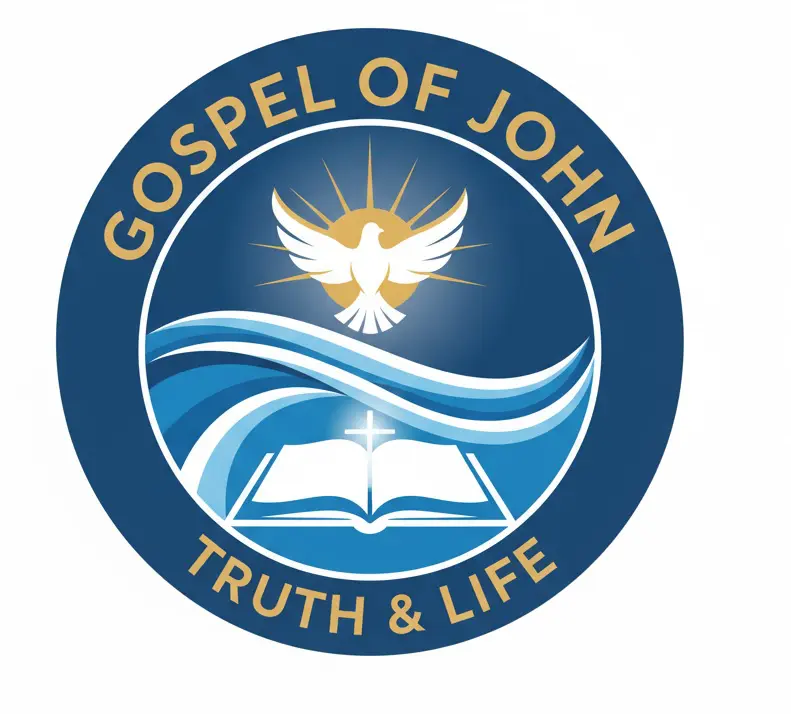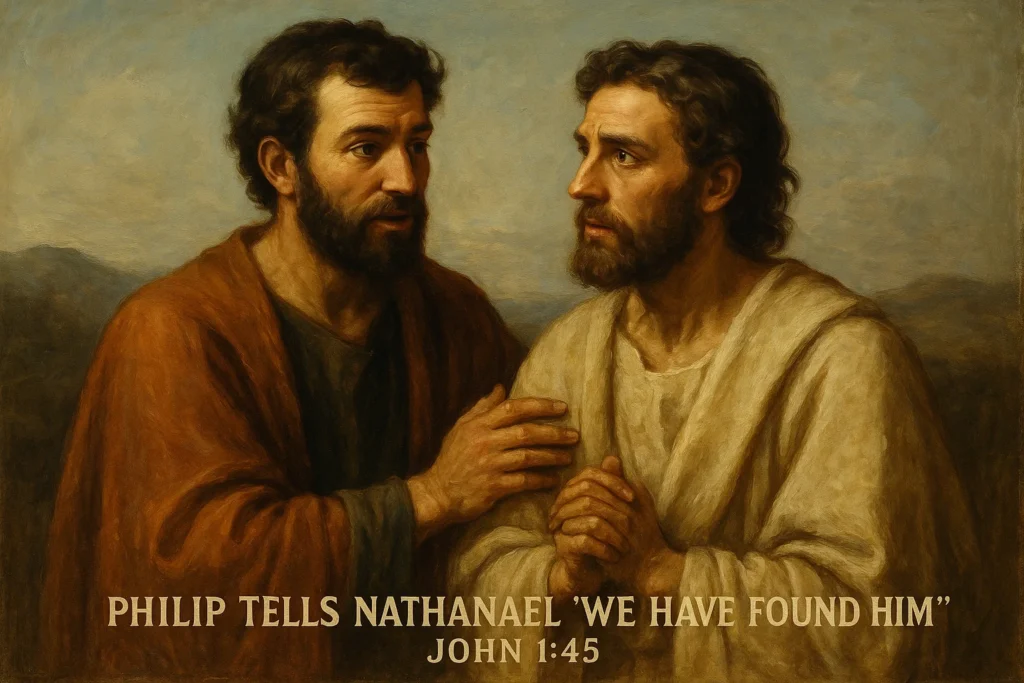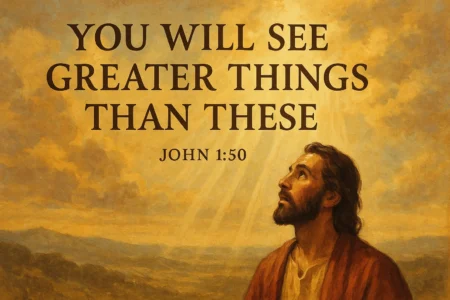“We found him.”
It’s a simple sentence. Just three words. But in the context of John 1:45, it’s arguably one of the most loaded, explosive sentences in human history. Imagine the scene. Philip, his mind still reeling from a life-altering conversation with Jesus, literally runs to find his best friend, Nathanael. He’s out of breath, his eyes wide. He doesn’t say “hello.” He doesn’t ask “how are you?” He grabs him and says, “We have found him of whom Moses in the Law and also the prophets wrote, Jesus of Nazareth, the son of Joseph.”
He’s not just saying “I met a cool teacher.” He’s saying, “Everything we’ve ever waited for? The entire story of our people? All those prophecies we’ve spent our lives studying? It’s over. The waiting is done. He’s here. I met him.”
This single verse, this breathless conversation between two friends, is the entire Gospel in miniature. It’s a hinge on which history turns. The John 1:45 meaning isn’t just about a historical report; it’s about the cataclysmic, personal discovery that God’s ancient promises had finally crash-landed in reality, in a specific man from a specific, forgettable town. It’s a claim that’s as personal as it is audacious. And it kicks off one of the most revealing and human interactions in the whole Bible.
More in John Chapter 1 Category
Key Takeaways
- The Wait Is Over: At its heart, John 1:45 is Philip’s excited, world-changing shout to his friend Nathanael that the long-promised Messiah has finally arrived.
- Connecting the Dots: Philip’s first instinct is to connect this new person, Jesus, to their shared history. He immediately identifies him as the one “of whom Moses in the Law and also the prophets wrote.” This wasn’t a new religion; it was the fulfillment of their own.
- A Real-World Address: Philip doesn’t present a ghost or a theory. He presents a real man: “Jesus of Nazareth, the son of Joseph.” The divine promise has a human name and a hometown.
- Friend-to-Friend First: This is the Bible’s prime example of relational evangelism. Philip’s first thought after meeting Jesus wasn’t to write a scroll or preach in the market. It was to tell his best friend.
- It Kicks Off an Argument: This excited declaration immediately slams into a wall of skepticism. Nathanael’s famous reply (“Can anything good come from Nazareth?”) is a direct result of Philip’s claim, and Jesus handles it brilliantly.
- The Bottom Line: The ultimate John 1:45 meaning is that all of God’s abstract, ancient promises have been kept in the real, tangible, and totally unexpected person of Jesus.
So, Who Is This Guy Philip, Anyway?
To really get the punch of this verse, we have to know who’s talking. This isn’t a high priest issuing a decree from the temple steps. This is just a guy, breathless, talking to his friend.
What Do We Know About Philip the Apostle?
Philip was one of the originals. Right before this, in verse 43, Jesus just walks up to him, finds him, and hits him with a two-word command: “Follow me.” That’s it. And Philip does.
Like Peter and Andrew, he was from Bethsaida, a fishing town. And from what we see later in the Gospel of John, he seems to be the practical, numbers-and-logic guy in the group.
He’s the one who, when Jesus asks about feeding 5,000 people, immediately starts doing the math in his head and says, “Uh, Lord, 200 days’ wages wouldn’t even be enough to give everyone a single bite.” You can almost see him pulling out an abacus. Later on, after years with Jesus, he’s still the one who says, “Lord, just show us the Father, and that’ll be enough for us.”
He’s relatable. He’s the “I need to see it to believe it” guy.
And what’s the very first thing this practical, no-nonsense man does after Jesus says “Follow me”?
He sprints to find Nathanael.
That right there tells you everything. Philip’s encounter with Jesus wasn’t just a mild curiosity. It wasn’t just “intellectually stimulating.” It was a core-shaking event. It was news so big he couldn’t keep it in. His first reaction wasn’t to go find a quiet place to journal about it. His first reaction was to run.
Why Was Nathanael His First Stop?
The text doesn’t spell it out, but the implication is thick enough to cut with a knife. Nathanael was his best friend. His study partner. His confidant.
You don’t share this kind of news with a casual acquaintance. You share it with the person whose opinion matters most. The person you need to be in on this with you.
I’ll never forget the day I got the call that my first book was getting published. It was a dream I’d had since I was a kid. After I hung up with the agent, I just sat there, completely stunned. The first person I called? It wasn’t my parents. It was my best friend, Mark. He picked up, and I couldn’t even form a sentence. I just yelled, “They said yes!”
That’s Philip.
This is a “they said yes” moment on a cosmic scale. His friendship with Nathanael meant he couldn’t let his friend stay in the dark for one more second. This wasn’t some calculated missionary strategy. This was a spontaneous, joyous, “you are not going to believe this” explosion.
“We Have Found Him” – What Did This Really Mean to a First-Century Jew?
Philip’s words are a theological stick of dynamite. To our 21st-century ears, “We have found him” sounds pretty straightforward. But to Nathanael, a devout Jew who had spent his life studying the Scriptures, every single word would have landed with the force of a hammer blow.
Who Exactly Were They “Looking For”?
Let’s be clear: they weren’t just looking for a good teacher or a new moral philosopher. For hundreds of years, the Jewish people had been living under the boot of foreign occupiers—first the Babylonians, then the Persians, then the Greeks, and now the Romans. And through all that time, they were clinging to a promise.
They were waiting for “Him.”
They called him the Messiah (from the Hebrew Mashiach) or the Christ (from the Greek Christos). Both words mean the same thing: “The Anointed One.” This was the figure promised by God to come and save Israel, restore its fortunes, and set things right.
But what he would be like was a subject of intense debate. What were they expecting?
- A New King David: Many hoped for a warrior-king, a political genius who would rally the troops, overthrow the Roman legions, and put Israel back on the map as a sovereign power.
- A New Moses: Others looked for a great prophet, a new lawgiver who would interpret the Torah with final authority and lead the people back to true righteousness.
- A Heavenly Judge: The prophet Daniel spoke of a “Son of Man” coming on the clouds of heaven, a divine figure who would judge the nations and establish God’s eternal kingdom.
- A Suffering Servant: The prophet Isaiah wrote about a mysterious figure who would suffer for the people, who would be “pierced for our transgressions” to bring healing.
These ideas were all swirled together in a complex, combustible stew of national hope and religious longing.
So when Philip shows up, gasping for air, and says, “We have found him,” he’s pointing to this entire web of expectations and yelling, “It’s done. The wait is over. He is here.”
What’s the Big Deal About “Moses in the Law”?
This is Philip’s proof. This is his “Exhibit A.” He’s not just running on a gut feeling. He’s making a direct, scholarly claim that this Jesus is the fulfillment of the Torah—the first five books of the Old Testament, the absolute bedrock of Jewish faith, law, and life.
He’s almost certainly thinking of one specific, massive prophecy. In Deuteronomy 18:15, Moses himself tells the people: “The LORD your God will raise up for you a prophet like me from among you, from your fellow Israelites. You must listen to him.”
For a thousand years, the question had been, “When? When will the prophet like Moses finally come?”
Philip’s claim is staggering. He’s telling Nathanael, his studious friend, that this carpenter from Nazareth is the new Moses. The ultimate prophet. The final, living Word from God. He is anchoring his brand-new, personal discovery in the most ancient authority they both revered.
…And What About “Also the Prophets”?
As if claiming the fulfillment of the Law wasn’t enough, Philip throws in “and also the prophets” for good measure. This casts the net over everything else—the entire sweep of the Hebrew Scriptures (the Nevi’im and Ketuvim).
This one little phrase is doing so much work. It’s invoking a massive library of messianic clues and promises.
Philip is effectively saying: “Nathanael, you know that ruler Micah said would come from tiny Bethlehem? (Micah 5:2). You know that ‘Wonderful Counselor’ and ‘Prince of Peace’ Isaiah promised? (Isaiah 9:6). You know Zechariah’s king who would ride in on a donkey? (Zechariah 9:9). You know that ‘Suffering Servant’ from Isaiah 53? It’s all of them. It’s all one person. And I had lunch with him.”
This is not a small, tentative claim. It’s an all-or-nothing, bet-the-farm declaration that this one man, Jesus, is the single focal point for all of Israel’s history and all of God’s promises.
The Shocking Letdown: “Jesus of Nazareth, the Son of Joseph”?
And then, right after making this earth-shattering, cosmic-level theological claim, Philip delivers the punchline.
Who is this fulfillment of all prophecy? This new Moses, this Davidic King, this Son of Man?
“Jesus of Nazareth, the son of Joseph.”
You can just imagine the record-scratch sound effect. This is where the John 1:45 meaning goes from the celestial to the terrestrial, from scrolls of ancient prophecy to the dusty streets of a specific, dead-end village.
Why Was “Nazareth” Such a Deal-Breaker?
Nathanael’s famous, cynical, and utterly human reply comes in the very next verse: “Nazareth! Can anything good come from there?”
This wasn’t just idle snobbery. It was a genuine, logical, and theological problem.
Nazareth was nothing. It was a tiny, obscure, agrarian village in Galilee, a region already looked down on by the Judean elite in Jerusalem. Nazareth isn’t even mentioned once in the entire Old Testament. It wasn’t on anyone’s prophetic map. It was the boonies. It was the ancient equivalent of saying the savior of the world is from Podunk, Illinois.
If you were expecting a king, you’d look to Jerusalem, the city of David. If you were a stickler for prophecy, you’d be looking for someone born in Bethlehem.
Nobody—literally, nobody—was looking for the Messiah to show up in Nazareth.
The claim and the candidate just didn’t compute. Philip’s grand announcement about Moses and the prophets just slammed face-first into the brick wall of mundane reality.
How Does “Son of Joseph” Make It Even Worse?
This just grounds the claim even further in the dirt. Philip isn’t presenting a mystical apparition or a divine being descending on a cloud. He’s presenting a man. A guy. A man with a known father, Joseph, who was the local carpenter.
This is the central scandal and paradox of the Christian faith, laid bare in Philip’s simple introduction.
The one of whom Moses and the prophets wrote is… the carpenter’s son.
This is what John’s Gospel is all about. It begins with the most cosmic, philosophical language possible: “In the beginning was the Word, and the Word was with God, and the Word was God” (John 1:1). Just 44 verses later, that same “Word” is identified as “Jesus of Nazareth, the son of Joseph.”
The contrast is meant to be breathtaking. Philip is holding two seemingly impossible truths in his hands at the same time: this man is the fulfillment of everything, and he’s also this regular guy from a town with a bad reputation.
What Can We Learn from Philip’s “Evangelism Strategy”?
Philip’s approach here is one of the most studied and imitated in history. But what’s so brilliant about it is that it’s not really a “strategy” at all. It’s just an explosion of genuine, unprocessed belief.
Is “We Have Found Him” the Perfect Pitch?
It’s perfect because it’s not a pitch. It’s authentic. Philip isn’t following a script. He’s not trying to “close a sale” or win a convert. He is simply overflowing with the most incredible news he has ever heard.
As someone who works with code for a living, I get a tiny taste of this. Sometimes I’ll wrestle with a bug for days. I mean, just banging my head against the wall, reading forums, trying everything. Nothing works. Then, suddenly, at 2 AM, I’ll spot it. One semicolon out of place. One logical flaw. I fix it, hit ‘compile,’ and the whole thing just works.
In that moment, I don’t calmly draft a memo to my project manager. I jump on Slack, ping my lead developer, and just spam him: “I GOT IT! IT WAS THE THING! I FOUND IT!”
That’s Philip.
He’s not selling anything. He’s sharing everything. His message is so powerful because it’s not a canned speech. It’s a personal testimony, and it has three parts that are impossible to fake:
- It Was Personal: “We have found…” He’s not a detached third-party reporter. He’s a participant. He’s all in.
- It Was Declarative: “We have found him.” There’s no “I think…” or “I’m feeling like maybe…” or “Would you be interested in hearing about…” It’s a statement of fact, spoken with the white-hot conviction of a brand-new discovery.
- It Was Rooted: “…of whom Moses and the prophets wrote.” He immediately connects his personal experience to their shared, authoritative story. He’s saying, “This isn’t just my new idea. This is the old idea, finally come true.”
How Did Philip Handle That Wall of Skepticism?
This, right here, is the most brilliant part of the whole exchange. When Nathanael hits him with that cynical, dismissive zinger—”Can anything good come from Nazareth?”—Philip doesn’t take the bait.
He doesn’t argue. He doesn’t get defensive. He doesn’t start quoting more prophecy. He doesn’t get into a geographical debate about the merits of Nazareth vs. Bethlehem.
He gives a three-word answer that is, and always will be, the perfect, most powerful response to all honest skepticism:
“Come and see.”
That’s it. Philip knows his words can’t convince Nathanael. His testimony is just the invitation. The encounter is what will do the work. He is so completely confident in Jesus that he knows he doesn’t have to win the argument. He just has to get his friend in the same room.
This “come and see” model is the practical, rubber-meets-the-road application of the John 1:45 meaning. The proclamation (“We have found him”) is pointless without the invitation (“Come and see”).
Nathanael’s Encounter: What Happens When He “Comes and Sees”?
The full meaning of Philip’s statement in 1:45 is only unlocked when we see what happens next. The setup is great. The payoff is legendary.
Nathanael, to his eternal credit, goes. He’s a skeptic, but he’s not a cynic. His prejudice doesn’t stop him from being curious. He huffs, he rolls his eyes, but he follows Philip.
What Did Jesus See in Nathanael?
As Nathanael shuffles up, probably with his arms crossed, Jesus looks at him and says to the group, “Here is a true Israelite, in whom there is no deceit.” (John 1:47).
This just stops Nathanael in his tracks. His guard is all the way up. He’s come to size up this supposed Messiah from the sticks, and the first thing Jesus does is pay him the highest compliment one Jew could give another. “No deceit” (or “no guile”) means he’s an open book. A man of integrity. What you see is what you get.
It implies that his skepticism wasn’t malicious. It was honest.
Nathanael is completely disarmed. He just says, “How… how do you know me?”
What’s the Big Secret About the Fig Tree?
Jesus’s response is what shatters Nathanael’s entire world: “I saw you while you were still under the fig tree before Philip called you.” (John 1:48).
Why was this so powerful? This is not just Jesus saying, “I saw you sitting over there.” This is a moment of pure, supernatural knowledge. In that culture, a fig tree, with its large, dense leaves, was a prized spot for shade. Devout Jews and rabbis would often sit under their personal fig tree to pray, meditate, and, most importantly, study the Torah in private. As the Vanderbilt Divinity Library points out, sitting “under one’s fig tree” was a well-known rabbinic image for the study of the Law.
Jesus is saying, “Before your friend even ran to get you, I saw you. I saw you in your most private, personal moment of devotion. I saw you sitting there, searching the Scriptures, praying, probably asking God when the Messiah would finally come.”
He didn’t just see Nathanael. He saw Nathanael’s heart.
From “Nazareth?” to “You Are the Son of God!”
That one sentence. That’s all it took. It obliterates all of Nathanael’s theological objections, all his geographical snobbery, all his skepticism.
Why? Because his skepticism was rooted in his knowledge of the Scriptures. But it was just overcome by a personal encounter with someone who was supernaturally in on his search.
He goes from 0 to 100 in a nanosecond. His response is immediate and absolute: “Rabbi, you are the Son of God! You are the King of Israel!” (John 1:49).
Look at the titles! “Rabbi” (the great teacher). “Son of God” (a divine title). “King of Israel” (the political, Davidic, messianic title). Nathanael, the ultimate skeptic, in a single instant, affirms that Jesus is the fulfillment of all the messianic expectations.
Philip’s audacious claim—”him of whom Moses and the prophets wrote”—was just confirmed. Not by a logical argument, but by a personal, supernatural revelation.
Why Does the John 1:45 Meaning Still Matter So Much Today?
This isn’t just a 2,000-year-old story. The exact same dynamic between Philip and Nathanael plays out in our lives every single day. The meaning of John 1:45 is as raw and relevant now as it was then.
Are We Still Looking for “Him”?
Humans are searchers. It’s baked into our DNA. We are restless. We are looking for meaning, for purpose, for “the one” thing that makes it all make sense. We look for it in our careers. We look for it in relationships. We look for it in political movements, in philosophies, in self-help books, in late-night scrolling.
Philip’s cry, “We have found him,” speaks directly to that universal, restless seeking in the human heart. It’s a claim that the search is over. That the answer isn’t just an idea or a system or a program.
The answer is a person.
We All Have Our Own “Nazareths”
We are just as skeptical as Nathanael. We all have our own “Nazareths.”
We have people, political parties, groups of people, or ideas that we dismiss out of hand without a second thought. “Oh, those people? Can anything good come from them?” We let our prejudices and assumptions build walls.
I’ll be blunt: for years, I had a good friend who was trying to get me to try rock climbing. I thought it was the dumbest thing in the world. “Why would I drive two hours to fall off a rock? It’s for adrenaline junkies with a death wish. Nothing good can come from that.” I dismissed it completely. My mind was made up.
It wasn’t until he finally just wore me down. He didn’t argue. He just said, “Dude, just come one time. I’ll pay for the pass. If you hate it, I’ll never mention it again.” He just said, “Come and see.”
So I went. And I discovered it wasn’t about adrenaline at all. It was about problem-solving, focus, and trust. It was like a physical chess game. It completely changed my perspective. My prejudice just couldn’t survive the actual encounter.
Nathanael’s story is a powerful, timeless challenge to our own biases. It’s a reminder that the most profound truths, the most life-changing discoveries, often come from the places we’ve already written off.
The Enduring, Revolutionary Power of “Come and See”
In our world, we are obsessed with being right. Our entire online ecosystem is built on winning arguments, “dunking on” the other side, and proving our own tribe is the smart one. We post our “evidence.” We drop our “facts.” We argue in comment sections until we’re blue in the face.
Philip’s approach is the exact opposite. It’s revolutionary.
He doesn’t try to win. He invites.
The John 1:45 meaning is a proclamation of a stunning discovery, but it’s a proclamation that knows its own limits. It knows that words and arguments can only take you so far. A personal testimony is just the map. The encounter is the destination.
This story gives us a blueprint for sharing the things that matter most to us. It’s not about being the smartest person in the room. It’s not about having a snappy comeback for every cynical question.
It’s about having an authentic discovery of our own. And then having the courage to turn to a friend, prejudices and all, and say, “I can’t explain it all. I don’t have all the answers. But I’ve found something real. I’ve found someone. Just… come and see for yourself.”
John 1:45 isn’t a dusty line of scripture. It’s a spark. It’s the sound of a human heart so full of a new discovery that it must speak. It’s the audacious claim that all the big-picture promises of God have a small-town address. It’s a story that’s still playing out, every time one person turns to another and says, “I’ve found him. You have to meet him.”
FAQ – John 1:45 Meaning
Why does Philip refer to Jesus as ‘the one of whom Moses and the prophets wrote’?
‘The one of whom Moses and the prophets wrote’ is Philip’s way of affirming that Jesus is the fulfillment of Old Testament messianic prophecies, linking him to the long-awaited figure foretold in Jewish scripture.
How does Philip’s personal declaration ‘We have found him’ serve as a model for evangelism?
Philip’s declaration exemplifies authentic, heartfelt sharing of good news based on personal experience, emphasizing that effective evangelism involves genuine belief and inviting others to see Jesus for themselves rather than relying solely on arguments.
What was the reaction of Nathanael to Philip’s announcement, and what does it reveal about skepticism?
Nathanael’s skeptical question about whether anything good can come from Nazareth reveals the common doubts about seemingly insignificant origins, but his eventual belief shows that a personal encounter with Jesus can overcome prejudice and skepticism.
Why is the phrase ‘Come and see’ important in the story of John 1:45?
‘Come and see’ is a powerful invitation that shifts the focus from argument to personal experience, illustrating that genuine belief often begins with an open invitation to encounter Jesus directly rather than through explanation alone.





